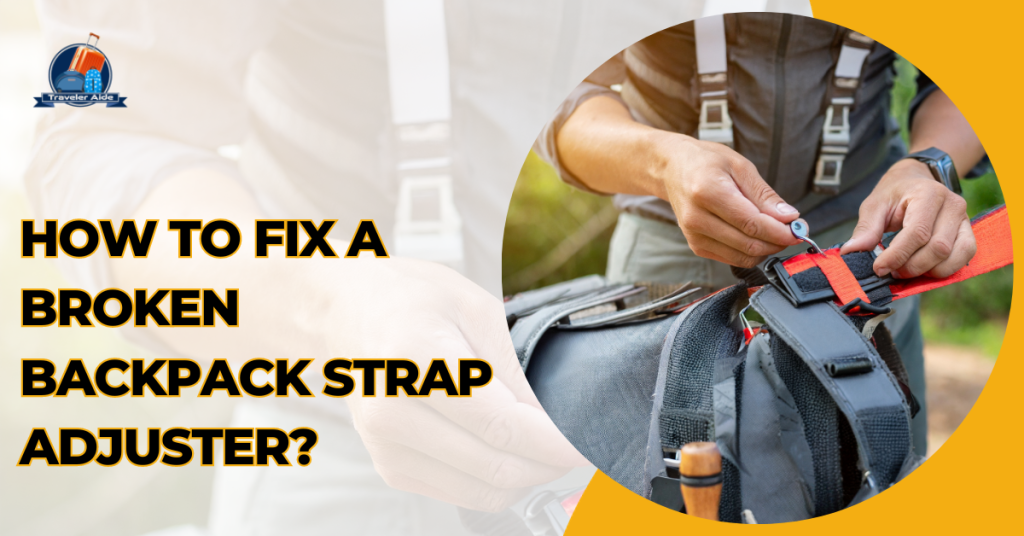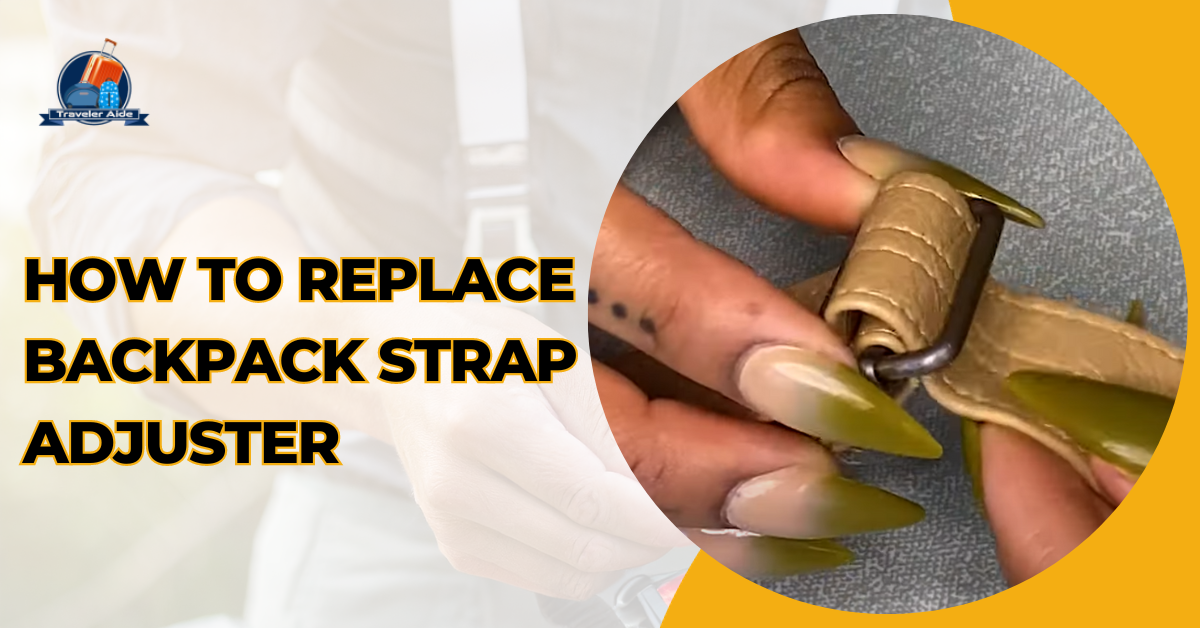🎉Greetings, backpack lovers!🎉
I am Dorothy E. Turner, a backpack specialist. I have been using backpack for over ten years, and I have helped many people choose and care for their backpacks. I’m thrilled to share my extensive knowledge with you once again.
Today, I’m diving into a topic that many of you have inquired about: “how to replace backpack strap adjuster?” Since I’ve been using bakpack for a long time, I know that a broken strap adjuster can be very annoying, even cause to lead you become disoriented.
Don’t be afraid!😊
In this comprehensive guide, with my backpack-using experience, I’ll teach you how to replace backpack strap adjusters. This DIY journey to restore your backpack to its former glory. So, let’s get started!
Can a Backpack Strap be Repaired?
Yes, a backpack strap can be repaired in most cases. The type of repair will depend on the extent of the damage. For minor tears or rips, you can simply sew the fabric back together. For larger tears or rips, you may need to replace the entire strap. You can also repair the buckle or adjuster if it is broken.
How to Replace Backpack Strap Adjuster: Quick and Simple Way
Replacing a backpack strap adjuster is a relatively straightforward process that can be done with a few basic tools and materials. Here’s a step-by-step guide:
Tools and Materials Needed:
- Seam ripper
- New strap adjuster
- Sewing needle
- Strong thread
- Scissors
Step 01: Remove the Existing Strap Adjuster:
1. Locate and remove the stitching holding the old strap adjuster: Examine the strap carefully to identify the stitching that secures the old adjuster in place. The stitching may appear as a series of straight or zigzag lines, typically holding the adjuster against the strap.
2. Use a seam ripper for careful removal: A seam ripper is a small, pointed tool designed for precisely cutting through stitches. Insert the seam ripper’s pointed end under the stitching that holds the strap adjuster. Gently push and cut the stitches, taking care not to damage the strap or surrounding material.
3. Gently pull out the old strap adjuster: Once the stitching is sufficiently removed, the old strap adjuster should become loose. Carefully pull the old adjuster out of the strap. If the adjuster is stubborn, continue to cut any remaining stitches with the seam ripper.
4. Discard a broken adjuster if necessary: If the strap adjuster is damaged or broken, it’s advisable to discard it. Ensure that no remnants of the old adjuster, such as broken pieces or sharp edges, remain embedded in the strap.
Step 02. Attach the New Strap Adjuster:
1. Thread the strap through the new adjuster: Take one end of the strap and thread it through the new strap adjuster. Follow the manufacturer’s guidelines if there are specific instructions for threading.
2. Ensure a secure fit in the adjuster: Once threaded, make sure the strap sits securely in the adjuster. Check that there is no slippage or looseness in the strap within the adjuster.
3. Sew the webbing to the adjuster using a needle and strong thread: Use a sewing needle and strong, durable thread suitable for the material of the strap. Begin sewing by anchoring the thread through the webbing and adjuster, creating a stable starting point.
4. Tight and secure stitching is crucial: Sew the webbing to the adjuster with tight and secure stitches. Choose a stitching pattern that provides strength and stability. For instance, a simple back-and-forth or crisscross pattern can be effective.
5. Trim excess thread after stitching: Once the stitching is complete, trim off any excess thread using scissors. Ensure that the trimmed ends are secure and won’t unravel.
Step 03. Reassemble the Strap:
1. Thread the strap back through the backpack: Begin by threading the loose end of the strap back through the designated loop or attachment point on the backpack. Ensure the strap is passed through any necessary sliders or loops according to the original design.
2. Check alignment and ensure the buckle is not twisted: Before securing the strap, check that it is properly aligned and not twisted. Ensure that any buckles or other components are in their correct positions.
3. Sew the strap back onto the backpack with strong and tight stitching: Once the strap is properly threaded through the backpack, use a sewing needle and strong thread to reattach it securely. Sew through the strap and the backpack material, creating a strong connection. Employ a stitching pattern that ensures stability and durability.
4. Trim excess thread after stitching: After completing the stitching, trim any excess thread using scissors. Trim close to the fabric to create a neat and finished appearance.
Step 04. Inspection and Testing:
1. Inspect the repaired strap for loose stitches or potential issues:
Carefully examine the entire length of the repaired strap. Look for any signs of loose stitches, frayed edges, or other potential issues. Pay special attention to the areas where the strap is attached to the backpack and where the new adjuster is secured.
2. Test the strap by adjusting it to different lengths, ensuring smooth functionality:
Adjust the strap to different lengths to test the functionality of the new strap adjuster. Ensure that the adjuster holds the strap securely in place at various lengths without slipping. Check for any resistance or difficulty in adjusting the strap length, as this could indicate a problem with the new adjuster or the stitching.
Additional Tips:
- Choose a strap adjuster that matches the size and style of your backpack.
- Use a sewing machine if you have one for faster and more consistent stitching.
- If the strap is made of a thick or durable material, you may need to use a heavier needle and thread.
With these steps and tips, you should be able to successfully replace a backpack strap adjuster and extend the life of your backpack.
How to Fix a Broken Backpack Strap Adjuster?

Fixing a backpack strap adjuster depends on the specific type of adjuster and the nature of the damage. Here are some general tips that might help:
01. For Plastic Buckles:
- Replacement Buckle:If the buckle is irreparably damaged, consider replacing it. Look for replacement buckles at outdoor stores, hardware stores, or online.
- Epoxy or Superglue: If the buckle is cracked but not completely broken, you can try using epoxy or super glue to bond the pieces together. Make sure to clean the surfaces before applying glue.
- Zip Ties or Paracord:In a pinch, you can use zip ties or paracord to create a makeshift strap adjuster. Thread them through the strap loops to create a temporary solution.
02. For Metal Adjusters:
- Pliers and Wire:If the adjuster is bent or misshapen, use pliers to carefully reshape it. If it’s a two-part adjuster, you might need to use wire to secure the pieces back together.
- Replacement Parts:Some backpacks allow you to purchase replacement parts. Check with the manufacturer or at outdoor equipment stores for spare parts.
- Sewing:If the strap is detachable, you might be able to sew it directly to the backpack, bypassing the adjuster. This is a more permanent solution but can be effective.
Remember that these solutions might be temporary, and it’s always best to replace or professionally repair essential gear when possible.
How Do You Install a Slide Adjuster?
A slide adjuster is a device use to adjust the length of straps or belts in various applications, such as backpacks, bags, or clothing. Installing a slide adjuster typically involves threading the strap through the adjuster and securing it in place. Here’s a general guide on how to install a slide adjuster:
Materials Needed:
- Slide adjuster
- Strap or belt
Installation Steps:
- Prepare the Strap: Ensure that the strap or belt you are using is the correct width for the slide adjuster.
- Open the Slide Adjuster: Most slide adjusters have a movable part that opens to allow the strap to insert. Locate the movable part and open it.
- Thread the Strap: Insert one end of the strap through the opening in the slide adjuster. The strap should go over any rollers or through any guides that are part of the adjuster.
- Adjust Length: Pull the strap through the adjuster to achieve the desired length. The adjuster should move smoothly along the strap.
- Secure the Strap: Once you have adjust the length, ensure the strap is securely held in place. Some slide adjusters have a locking mechanism or teeth that grip the strap to prevent slipping.
- Close the Slide Adjuster: If the slide adjuster has a movable part that was open, close it securely to hold the strap in place.
- Test the Adjustment: Pull on the strap to ensure that the slide adjuster is holding the desired length securely. Make any additional adjustments if needed.
Please note that the specific design of slide adjusters can vary; the steps provided here are a general guide and may not cover all variations of slide adjusters.
How to Fix a Torn Backpack Strap Without Sewing?
To fix a torn backpack strap without sewing, clean the torn area, apply a durable fabric adhesive on both sides of the tear, press them together, and hold them firmly. Consider adding a fabric patch for extra reinforcement. Once the adhesive sets, your backpack strap is ready for action. While this is a quick fix, consider a more permanent solution like sewing when possible.
How Do You Fix a Slippery Backpack Strap?
Tired of your backpack strap slipping off your shoulder during your adventures? Here’s a quick and easy fix! First, identify the material causing the slip; it’s often due to smooth or synthetic fabrics. Take a piece of moleskin or a similar textured material and attach it to the underside of the strap where it rests on your shoulder.
This added texture provides grip, preventing the strap from sliding. Another option is to wrap the strap with athletic or grip tape. Not only does this enhance the grip, but it also adds a touch of personal style. Experiment with these solutions to find what works best for you, and say goodbye to constantly readjusting your backpack strap during your travels!
How to Keep Backpack Straps from Slipping off Shoulders?
Keeping backpack straps from slipping off your shoulders is essential for a comfortable and hassle-free journey. One effective solution is to adjust the straps to ensure a snug fit. Tighten them enough to secure the backpack close to your body but without causing discomfort. Additionally, consider using backpack strap accessories like strap keepers or clips that can help hold the straps in place. Another trick is to wear the backpack higher on your back, with the straps positioned correctly on your shoulders.
If your backpack tends to slide off due to clothing material, try wearing garments with a bit of friction, like textured or non-slip fabric, to help anchor the straps. Experiment with these tips to find the best combination for you, ensuring a secure and comfortable backpacking experience.
Conclusion
In my many years of experience as a backpack specialist, I have helped countless backpackers replace broken strap adjusters. It is a relatively simple process that I have mentioned above in simple 4 steps. By following the simple steps in this guide, you can easily replace backpack strap adjuster and get back to enjoying your travels or hikes.
If you are not comfortable doing this yourself, you can always take your backpack to a professional for repair. However, if you are a little bit handy, you can save yourself some money by doing it yourself.
However, I’d love to hear about your experiences with this guide. Feel free to share your success stories or any additional tips you may have discovered along the way in the comments below.
Frequently Asked Questions about Backpack Strap Adjustments and Repairs
Q: How do you put a strap adjuster on a backpack?
A: Putting a strap adjuster on a backpack is a simple process. Locate the strap adjuster on your backpack, usually a sliding mechanism. Slide it up or down to adjust the strap length according to your preference, ensuring a comfortable fit.
Q: How do you replace a backpack strap buckle?
A: To replace a backpack strap buckle, start by identifying the type and size of the buckle on your backpack. Purchase a matching replacement buckle. Remove the old buckle by cutting it off or carefully undoing any stitching. Attach the new buckle securely, ensuring it is firmly in place. This straightforward process will have your backpack strap buckle replaced and functional.
Q: How to fix a broken backpack strap without sewing?
A: Fixing a backpack strap without sewing is possible with the use of strong adhesive or heavy-duty fabric glue. Begin by cleaning and drying the surfaces of the broken strap. Apply the adhesive according to the product’s instructions, bonding the broken ends together. Allow sufficient time for the adhesive to set. This provides a temporary solution until you can make more permanent repairs, offering a quick fix for your broken backpack strap.

Hey, I’m Dorothy E. Turner! I’ve spent years exploring the world and diving deep into the travel scene. Along the way, I’ve developed a real knack for understanding what makes a great travel backpack. I’m passionate about sharing my expertise to help fellow travelers find the perfect backpack for their adventures.



2 thoughts on “How to Replace Backpack Strap Adjuster: 4 Simple Steps!”